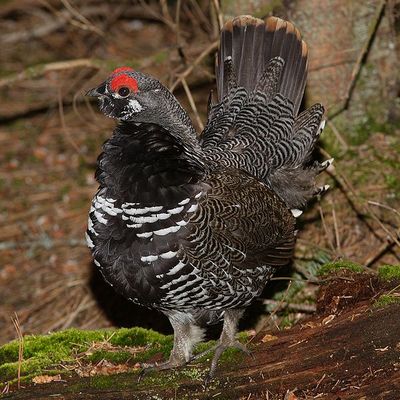Canada’s national bird is the grouse.
A Stuart Keate quotation
Spruce Grouse
The Spruce Grouse, Dendragapus canadensis, is a medium-sized grouse.
These birds forage on the ground or in trees in winter. They nest on the ground in dense growth. They are permanent residents. Some of them move short distances by foot to a different location for winter.
Identification Tips:
• Length: 13 inches
• Medium-sized, stocky, round-winged, chicken-like bird
• Long, squarish tail

Have you seen this bird?
• Red comb over eye
• Black throat with white border
• Black breast with white barring
• Gray plumage with white spots on belly and black barring on upperparts
• White spots on uppertail coverts on “Franklin’s Grouse”
• Black tail with pale brown terminal band or black tail feathers in “Franklin’s Grouse”
Adult female:
• Gray-brown or reddish-brown plumage with dark-brown and white barring on underparts
• Black tail with brown terminal band
The Spruce Grouse’s winter diet consists of conifer needles. In summer, they eat berries, green plants, and some insects. Spruce grouse also eat many pine and spruce tree buds, as they are high in energy. The also tend to eat pebbles. This tends to help their gizzard digest their food.
Canada’s national bird is the grouse.
By Stuart Keate
Bird Quotation Popularity Poll
(4 answers max)
 Loading ...
Loading ...
Add any comments below and/or indicate if you’ve seen this bird.
Canada’s national bird is the grouse.
Bird Quote Notice
If you have or know of a bird quote, bird quotes, or a bird quotation not yet on the site please submit it to Birdquote.com for others to enjoy.
Large view +
Spruce Grouse credit
- 30″ X-File Feathers and Related Tales « Pheasants Forever Blogs
- Pets Best Newsroom » Blog Archive » Pet health: Winter diet needs
- Old Christmas Trees Grow Summer Berries and Other Winter Garden Tips | Baristanet
- Snow & Trees | Winter in the Netherlands « Digital thoughts
- TheMusic.FM » Live Review: The Disco Biscuits New Year’s Run Hits Terminal 5 (Night 3)
- Old Duck Hunter: Spruce grouse on wing: Who’s stupid now? | The Mouth of The Kenai











I have heard these referred to as “those stupid birds” due to their habit of sitting on the road in groups where they are often hit by vehicles. It’s a wonder the species survives, possibly only saved by the lack of roads in the north. Not a good choice for a national bird, and it isn’t.